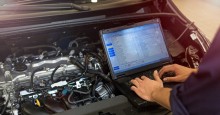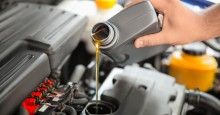
Happy women in car on road trip. Photo ID 99965013 © Monkey Business Images | Dreamstime.com
To ensure a smooth transition into spring and prevent potential issues, here's a comprehensive guide on the different items you should check on your car after the winter months.
Inspect tires and rotate:
Start by checking the tire pressure, as cold temperatures can cause tire pressure to drop.
Under-inflated tires decrease fuel efficiency and compromise safety. Also, inspect the tread depth for wear and tear.
Consider rotating the tires to ensure even wear, extending their lifespan and improving performance.
Evaluate brake system:
The winter season often involves driving on slippery roads, putting extra strain on the brakes.
Inspect the brake pads and discs for wear and tear. Unusual noises or reduced responsiveness can be signs of brake issues, and it's crucial to address them promptly to ensure optimal safety on the road.
Check fluid levels and changes:
Check all fluid levels, including engine oil, transmission fluid, brake fluid, and coolant.
Winter conditions can be harsh on fluids, and ensuring they are at the right levels is vital for the proper functioning of your vehicle. Consider changing the oil and oil filter as part of routine maintenance.
Test battery health:
Cold temperatures can be particularly challenging for car batteries.
Get a battery test to ensure it's holding a charge effectively. If you notice slow cranking or other signs of a weak battery, consider replacing it to prevent getting stranded unexpectedly.

Mechanic with computer check of vehicle.
Examine engine belts and hoses:
Inspect the engine belts and hoses for signs of wear, cracks, or leaks.
The cold weather can contribute to the deterioration of these components, and addressing issues early can prevent more significant problems later.
Check wiper blades and washer fluid:
The winter months often mean increased use of wiper blades and washer fluid. Your wiper blades get plenty of use in the winter. If worn down, replace them to properly wipe away springtime rain, pollen and dirt.
Inspect the blades for any signs of damage or wear, and replace them if necessary. Additionally, top off the washer fluid reservoir with a suitable solution to ensure clear visibility during spring showers.
Inspect alignment and suspension:
Potholes and rough road conditions during winter can impact the alignment and suspension of your vehicle.
If you notice uneven tire wear or experience steering issues, have the alignment and suspension checked by a professional.
Examine exhaust system:
Winter conditions can accelerate the corrosion of the exhaust system. Inspect the exhaust pipes and muffler for rust and damage. Addressing issues promptly can prevent exhaust leaks, which can be harmful to both you and the environment.
Other important March reminders including brakes and tires

Check, refill car fluids.
- Examine your tires for signs of wear, bulges, and scrapes. Should you notice any issues, seek assistance from your service advisor for inspection. It is crucial to replace tires with bulges promptly, as they pose a risk of blowouts.
- Switch to all-season tires if using winter tires. Warmer temperatures accelerate wear on the softer treads of winter tires, affecting their lifespan.
- Check brake pad/rotors. Do you hear squeaks and squeals? It could be a sign that your vehicle needs new brake pads.
- Inspect the underneath of your vehicle for leaks. Severe winter weather may have caused cracks in fluid lines that could cause damage to power steering and brakes.
- Replace your cabin air filter at the start of spring to ensure the removal of pollen and other allergens. Ask your service advisor to place a new filter during your next oil change.
- Repair any chips and cracks in your windshield that occurred during winter to avoid an expensive replacement. Small winter cracks or chips can turn into windshield replacement if not repaired.
- Keep your car looking good and protect its paint by applying a water-repellent treatment to your vehicle's windshield and windows to prevent spring rains from adhering to the glass surfaces off your car.
- Wash your vehicle with cleaners designed specifically for vehicle surfaces. use a terry cloth or microfiber towel to rinse and dry. Apply a ceramic-based car wax to keep your vehicle shining throughout spring rains.
Copyright © 2024 by Sensible Driver. All rights reserved.